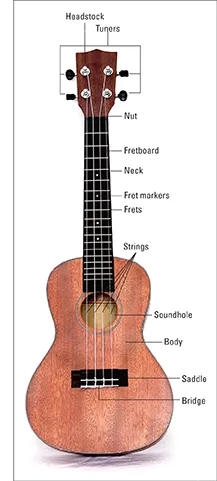Chapter 1
Ukulexicon
In This Chapter
Getting to know the ukulele
Looking at different sizes
Congratulations on choosing the ukulele! It’s the perfect instrument to pick up and start playing. It’s simple and unintimidating – and you don’t need to practice for weeks before you can make a pleasing sound.
In this chapter you discover a whole heap of words and phrases that fly around the ukulele world. Some people try to blind you with jargon but it’s all really simple when you know it. So, this section decodes everything for, so you can be an expert or, failing that, refer back here to find out what the jumping Jericho people are going on about.
This chapter goes over the different parts of the ukulele, the sizes it comes in and some basic musical language.
Looking at the Anatomy of a Ukulele
Ukuleles are usually shaped like small guitars, but other shapes are common (the pineapple shape is popular). The shape of the ukulele doesn’t usually make a great deal of difference to the sound. But some shapes, such as the Flying-V, are harder to play.
Avoid buying one of the more whacky ukulele shapes as your first ukulele. Whatever you do, avoid the Flying-V-shaped ukuleles. I got one as a gift and it was a trial having to keep a smile on my face as it poked me in the thigh and forearm.
Other shapes to tread carefully around are the triangular ukuleles and the cricket-bat-shaped electric ukuleles.
Ukuleles share many of their parts with people: for instance bodies and necks. And I’m lobbying strenuously to get the mouth officially renamed your soundhole. But until the full alignment of names, Figure 1-1 provides a guide to what you find on a ukulele.
Body: The body is the main part of the ukulele where the sound is produced. The type of wood this section is made of determines how the ukulele sounds. The most popular woods for the body are mahogany and koa (a Hawaiian wood).
The body is divided into three main parts: soundboard or top (the front of the uke), the back and the sides. The soundboard is the most important part (which is why you often see ukuleles with expensive woods used for the top and less expensive wood (or even plastic) on the back and sides.
Strings: Originally, ukulele strings were made from cat-gut and nylon. Nowadays, strings are made from synthetic fibres (with ugly names like fluro-carbon and nylgut) that combine the best features of both.
Unlike most string instruments, ukulele strings don’t go from fattest being nearest your head to thinnest being nearest the ground. This confused me when I first got a ukulele. I thought someone must have screwed up and I changed the order of the strings. I was an idiot.
Bridge: The bridge is attached to the front of the ukulele and holds the strings at that end. Two main types of bridges exist: one where you tie the strings to the bridge, and one where you knot the end of the string and thread it through a slit.
Figure 1-1: A typical ukulele with parts indicated.
Soundhole: The round hole on the front of your ukulele that lets the sound out. These holes are usually placed under the strings but not always. The placement of the soundhole doesn’t have any big impact on the sound.
Neck: The neck is the long bit that sticks out of the body. Ukulele necks are lighter and weaker than similar instruments like guitars and mandolins. They’re designed for nylon strings. So don’t be tempted to put steel guitar strings on your uke; it’ll snap the neck in two.
Fretboard: The strip of wood that runs along the neck just behind the strings. When you’re playing the ukulele, you press the strings down against the fretboard to produce notes. Most fretboards are made of rosewood.
Frets: The frets are strips of metal that go across the fretboard. They mark out the different pitches of the notes. The higher up the fretboard, the higher the note is musically.
Fret markers: Fret markers are the dots on the fretboard. They make it easier for you to spot which fret is which further up the neck. Ukuleles have fret markers on the 5th, 7th and 10th frets (and also at the 12th and 15th if the fretboard extends that far). (These fret markers can be a little confusing for guitar players who pick up a ukulele, because guitars have a marker at the ninth fret rather than the tenth.)
Headstock: At the end of the fretboard, you find the headstock. It’s there to hold the hold the tuners. But its main function is as an advertising hoarding for the maker.
Tuners: Tuners are attached to the headstock and hold the strings of the ukulele. You change the tuning of your strings by twiddling them. Two types of tuners exist:
• Friction tuners: Traditionally, ukuleles have friction tuners. These tuners stick out behind the ukulele and hold the strings in tune by friction alone.
If your ukulele has friction tuners, you may need to tighten the screws that hold them to the headstoc...
















